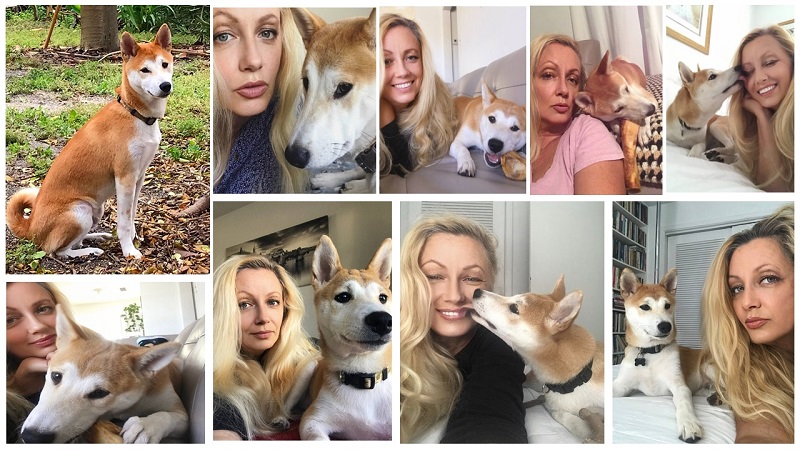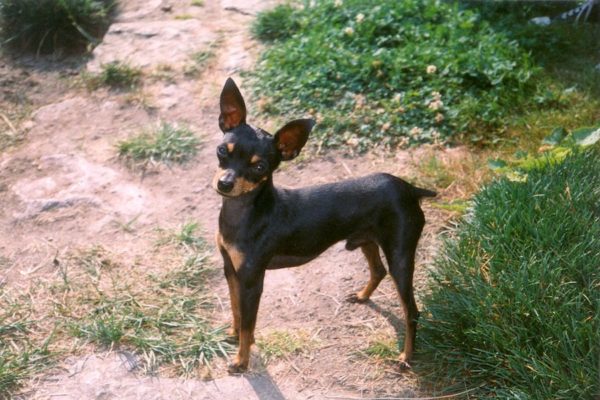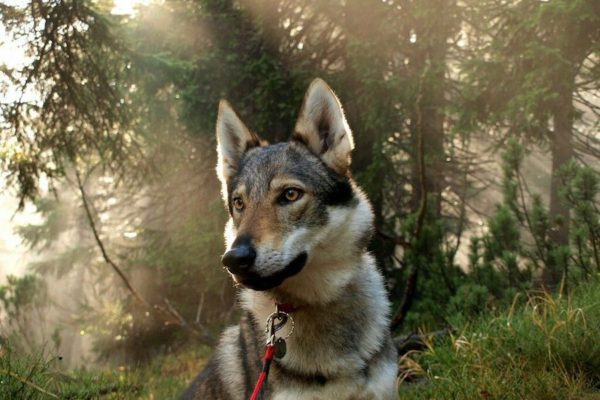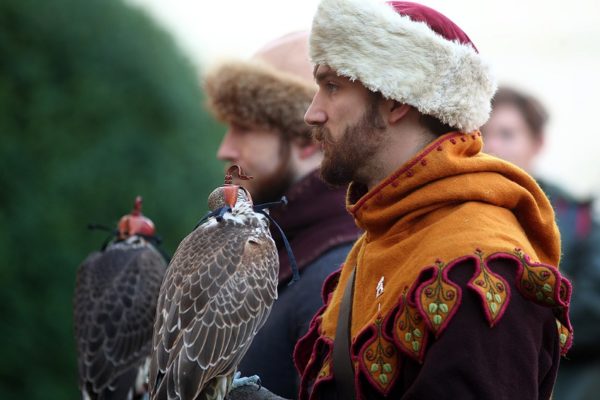The bond between owner and pet is like no other—they’re our companions, always along for the ride no matter what ups and downs life brings. They show us joy and make us laugh, and even listen to us like they know exactly what we’re saying. As the expression goes, a dog is a man’s best friend—and it’s easy to see why. They greet us at the door every day, love us unconditionally, and even help us humans live longer, happier lives.
Dogs come in all shapes and sizes, and frequently without pedigrees to describe their breed or heritage, and most all are loved by their owners, regardless of their backgrounds. Today we’re looking at Biological breeds originating in specifically in the Czech Republic and Slovakia. A total of seven Czech dog breeds are recognized on Czech national soil. Four dog breeds are from Slovakia.
1) Bohemian shepherd (Chodský pes)
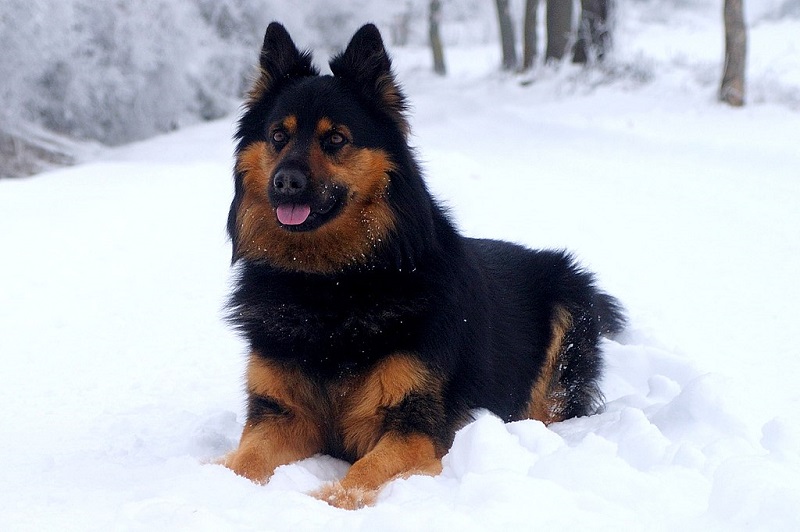
The Bohemian shepherd is a herding dog and guard dog, indigenous to the Chod region (around Domažlice) of southwest Bohemia. During the reign of King Premysl Ottokar II (1253-1278), the Kingdom of Bohemia recruited the ancestors of the Chodové from ethnic enclaves within the western Carpathian Mountain region near the borders of what is today Slovakia, Poland, and southwestern Ukraine. These communities were relocated to serve as border patrol along the borders between Bohemia and Bavaria. It is not known if the Bohemian shepherd accompanied the Chodové during relocation or if the breed was developed soon afterwards; however the breed quickly became a hallmark of the Chodové. By 1325, the King of Bohemia, John of Luxembourg, acknowledged as a condition of their relocation and border protection, the ancestral Chodové were granted significant privileges that differentiated them from other subjects, including the right to own large dogs forbidden to ordinary Bohemian peasantry.
The Bohemian shepherd would continue to be associated with the Chodové even after their agreement with the Kingdom of Bohemia was declared void in 1695. J.A. Gabriel, writing about Chodové in 1864, described the local people as “Psohlavci” (Czech: Dog-heads) as their pennon featured the silhouette of a Bohemian sheepdog with a longer coat at the neck. Alois Jirásek, writing in his 1884 novel “Psohlavci” concerning the Chodové revolt of 1695, used a Bohemian shepherd as a flag symbol for them. Writer Jindrich Simon bar wrote of “Chodsky dogs” from the Sumava region in 1923, describing them as “balanced and tenacious dogs used for guarding and protecting and rounding up cattle.” A modern breeding program for the Chodský pes began in 1984 and there are now many breeders. About 3,500 registered pups have been born since the program started (1984–2009).
Despite their appearances, there is no evidence to suggest they are related to German Shepherd dogs.
The Bohemian Shepherd has been historically bred in the Czech Republic. Until recent years, dog lovers in North America would undergo the long journey to the Czech Republic and difficult process of importing Bohemian Shepherds to the United States and Canada.
The exceptional qualities of the breed stimulated this small group of dedicated owners to form a club to promote the breed. The club started the process of having this breed officially recognized in North America. As of 2022, it is estimated there are roughly 50 Bohemian Shepherds in North America.
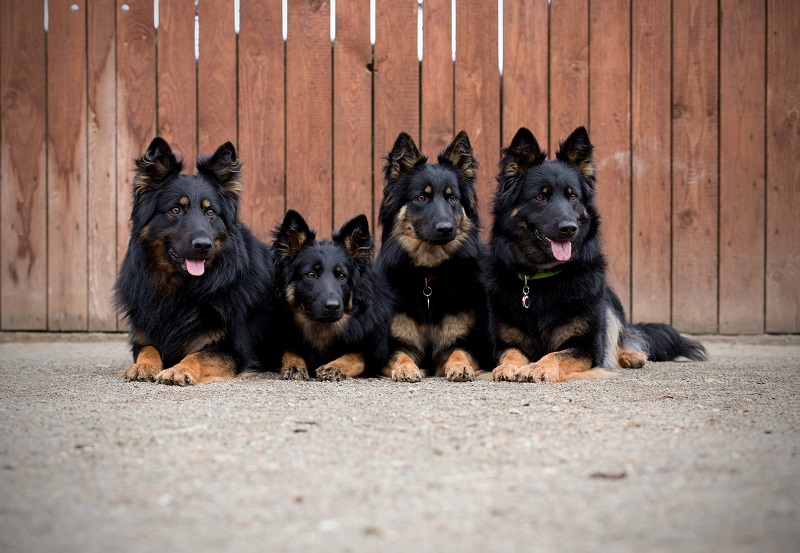
The club established standards with the objective of starting breeding programs in North America dedicated to best practices for healthy and diverse full bred gene pools. In 2019 an owner from California traveled with a female Bohemian Shepherd to the Czech Republic to be mated. The mating was successful, and puppies were subsequently whelped in California.
In 2022, one of the founding members of the club and owner of three Bohemian Shepherds became the first in North America to both breed and whelp Bohemian Shepherd puppies in the USA. Six males and one female were whelped in Illinois. This event placed the introduction of the breed to North America on a new level.
Bohemian Shepherds are lively and quick dogs. Quick learning and biddable, Bohemian Shepherds relate well to children and other pets. The breed is agile and has a keen sense of smell, making them proficient search and rescue dogs or a great companion for handicapped people, and an outstanding watch dog. This breed has a stable, calm, and friendly temperament that allows it to be good with the owner, his family, and especially with children.
2) Czechoslovakian Wolfdog (Československý vlčák)
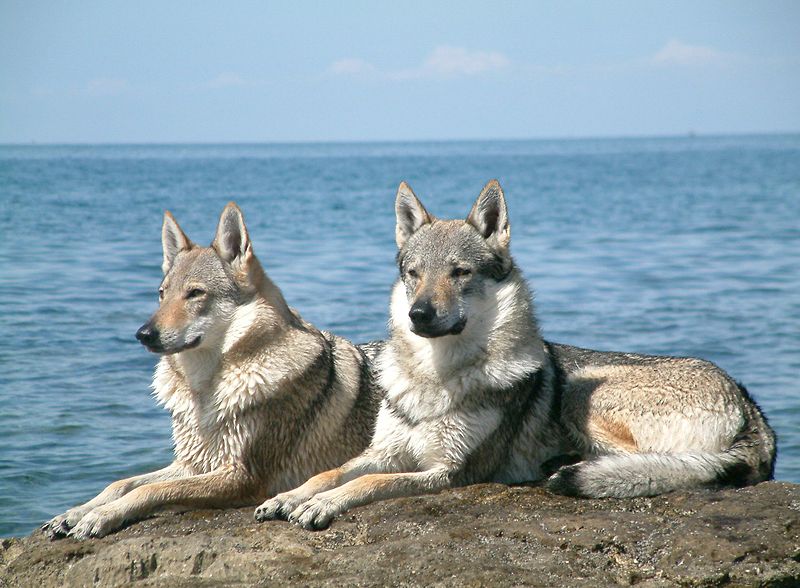
The Czechoslovakian Wolfdog (Czech: Československý vlčák, Slovak: Československý vlčiak, German: Tschechoslowakischer Wolfhund) is a wolf-dog breed that began as an experiment conducted in Czechoslovakia in 1955.
After initially breeding working line German Shepherds with Carpathian grey wolves, a plan was worked out to create a breed that would have the temperament, pack mentality, and trainability of the German Shepherd and the strength, physical build and stamina of the Carpathian wolf. The breed were originally used as Border patrol dogs but were later also used in search and rescue, Schutzhund sport, tracking, herding, agility, obedience, hunting, and drafting in Europe and the United States. It was officially recognized as a national breed in Czechoslovakia in 1982, and was officially recognized as a breed by Fédération Cynologique Internationale (FCI) in 1989.
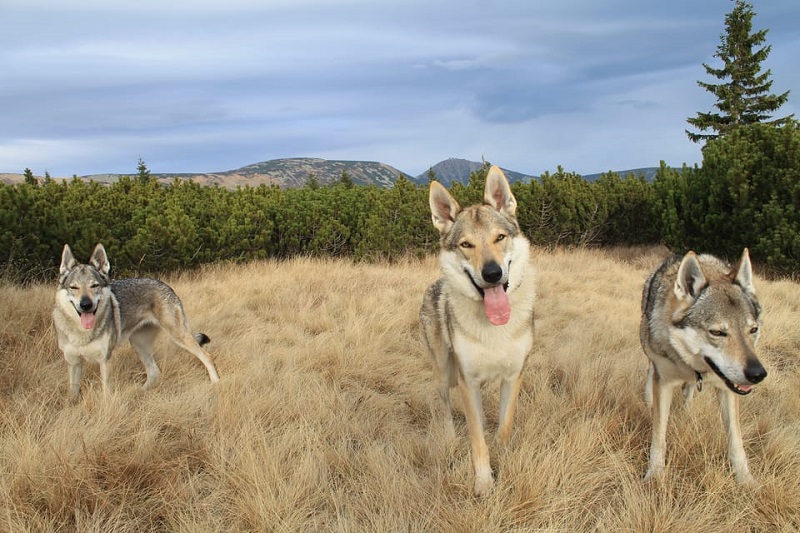
Photo: Michaela van Erne, Chovatelská stanice československých vlčáků
The Czechoslovak Wolfdog develops a very strong social relationship—not only with its owner, but with the whole family. It can easily learn to live with other domestic animals that belong to the family; however, difficulties can occur in encounters with strange animals. It is vital to subdue the Czechoslovak Wolfdog’s passion for hunting when it is a puppy to avoid aggressive behavior towards smaller animals as an adult. The puppy should never be isolated in the kennel; it must be socialized and get used to different surroundings. Female Czechoslovak Wolfdogs tend to be more easily controllable, but both sexes often experience a stormy adolescence.
We wrote a much more detailed post on this breed so make sure to read it at the link below:
About The Breed: Czechoslovakian Vlčak
3) Prague Ratter (Pražský Krysařík)
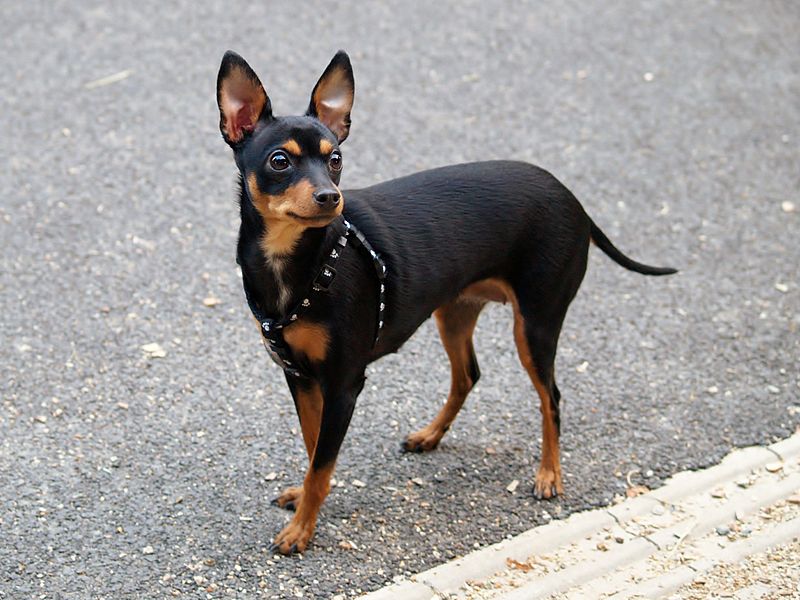
The Pražský Krysařík (Prague Ratter) is a small breed of dog from the Czech Republic that is rarely seen outside its country of origin. It is the smallest breed in the world by breed standard, because of the maximum height of the dogs, unlike Chihuahuas who are measured by weight.
Best known for its active and lively nature, the Prague Ratter is a spunky breed that is full of original character. These tiny dogs thrive on strong and dependable relationships with humans, love to receive affection and play the role of lap dog during down time. This breed is highly intelligent and generally responds well to basic training and commands. As a pet, the Prague Ratter is obedient, loyal, loving, and very affectionate.
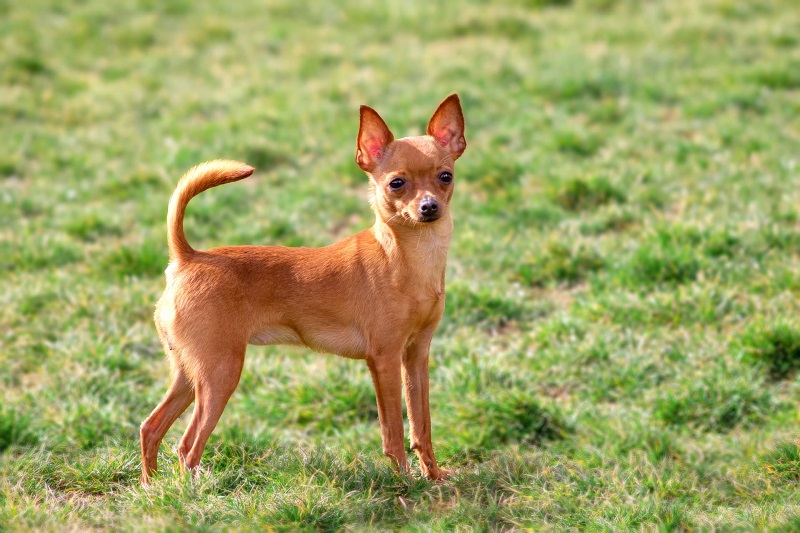
Photo: Pavla Čiháková
The Prague Ratter adapts well to full-time indoor and apartment living, yet still enjoys spending time outdoors, playing games such as fetch, and taking long and leisurely walks. They are also known to be a very quiet dog, unlike many other small dogs who tend to be very “yappy”. Like any small dog, one should be wary of allowing them to develop Small Dog Syndrome, as they can become aggressive if they are not well-socialized from an early age.
We also a detailed post on this breed so make sure to read it at the link below:
About The Breed: Prague Ratter
4) Cesky Terrier (Český teriér)
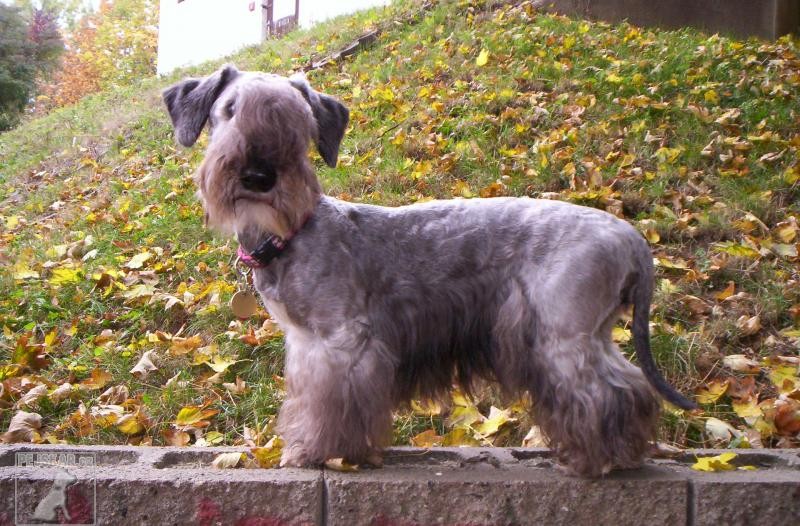
The Cesky Terrier (Český teriér, lit. ‘Bohemian Terrier’ or ‘Czech Terrier’) is a small terrier type dog originating in Czechoslovakia.
The Cesky Terrier was created by a Czech breeder, František Horák, in 1948, as a cross between a Sealyham Terrier and a Scottish Terrier, to create a terrier suitable for hunting in the forests of Bohemia. Although not a trained scientist, Horák worked for many years as a research assistant at the Czechoslovak Academy of Sciences and used knowledge gained there in his dog breeding. Czechoslovakia was ruled by a communist regime at the time; when Horák’s dogs became more popular around the world, he began to receive a large volume of mail from outside the country, which earned him the attention of the secret police. Horák died in 1997.
The Cesky Terrier was recognized for international competition by the Fédération Cynologique Internationale in 1963 as breed number 246 in Group 3, Terriers. The breed is now recognized by all of the major kennel clubs in the English-speaking world. The Cesky Terrier is one of the six most rare dog breeds worldwide.
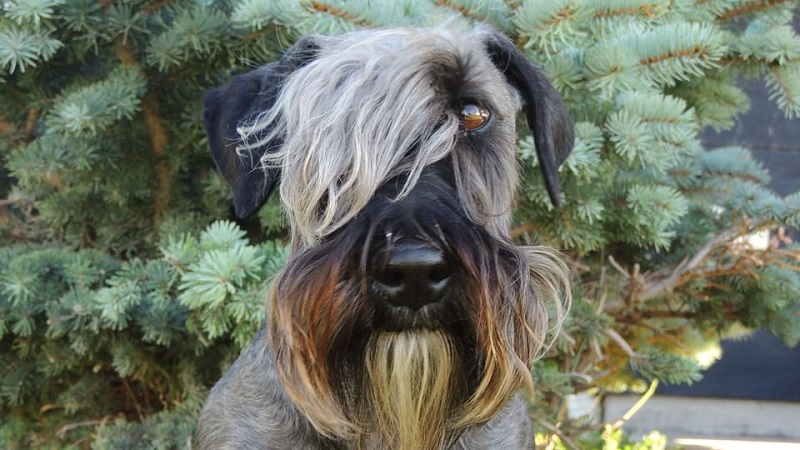
Photo: Martina Urbanová
The breed was first imported into the US in the 1980s by a group of enthusiasts. They formed the Cesky Terrier Club of America in January 1988. As interest grew, the breed became eligible to join the American Kennel Club (AKC) Foundation Stock Service Program from January 1, 2004 allowing it to compete in AKC Earthdog tests. At this stage the American Cesky Terrier Fanciers Association was formed and recognised by the AKC. It is the club accepted as the parent club by the AKC. However, the Cesky Terrier Club of America remains active in promoting the breed in the USA. From mid-2011, the Cesky Terrier was able to compete in the terrier group in America as it was accepted for entry in the AKC Stud Book.
The breed first arrived in the UK in 1989 and had to compete from the imported register. The Cesky Terrier was recognized by the Kennel Club (UK) in 1990 and on January 1, 2000 it gained rare breed status. It has since competed successfully in show competition in the UK.
The breed standard calls for a calm dog, and aggression is a disqualifying fault. Cesky Terriers are reputed to be less active and quieter than other terriers. This may or may not make them suitable pets for families with children.
5) Cesky Fousek | Bohemian Wire-haired Pointing Griffon (Český fousek)
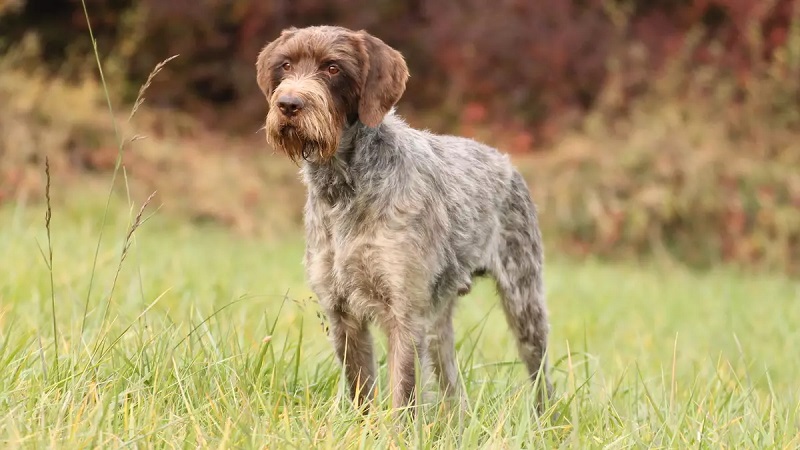
The Český Fousek is a Czech breed of versatile hunting dog that was traditionally and currently used to hunt, point, and retrieve. This refers to the dog’s natural ability in tracking, pointing, and retrieving game. The name is in Czech, in which český means Czech and fousek is derived from vousy (facial hair) or vousky (whiskers). While the name is used for both sexes, Český Fousek specifically refers to a male dog while the female is traditionally called Česka Fouska. The breed is part of the griffon hunting dog family and have the beard and moustache (“facial furnishings”) common to wirehairs. There is a large difference in size between the females and males of this breed, with the weight difference being up to 11 kilograms (24 lb).
The Český Fousek is a much newer wirehaired versatile hunting dog in relation to many other European or Continental breeds, with written standards first established in the nineteenth century and FCI recognition in 1964. The breed nearly became extinct in the 1920s, and was saved by dedicated breeders in Czech Republic by breeding with other versatile hunting breeds, such as the German Shorthaired Pointer and German Wirehaired Pointer. This caused problems for acceptance of the breed by the FCI as the German Kennel Club (Verband für das Deutsche Hundewesen) opposed it based on being nearly genetic identical to the Stichelhaar. Separately, this happened again in the US in the 1980s and 1990s with infusion of the Český Fousek into the Wirehaired Pointing Griffon, causing a split among members and the forming of two new and separate clubs,[4] the Cesky Fousek North America (formerly Bohemian Wirehaired Pointing Griffon Club of America) and the American Wirehaired Pointing Griffon Association.
The Český Fousek was used in the creation of the foundation stock of the Slovak Rough-haired Pointer.
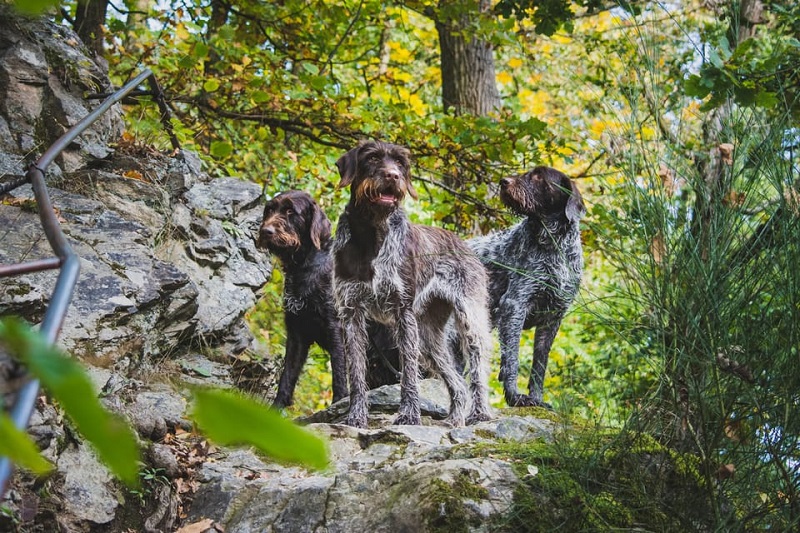
Photo: Libuše Rodová
The Czech Fousek is a loyal, kind and very agile and active dog, which is very fond of hunting. It is a good retriever on land and in water, but is most often used for exhibiting game. Males are more stubborn, females, on the other hand, are more calm. He is friendly and playful with his family and acquaintances, and takes longer to get used to strangers. During puberty, he can be overly dominant, but this will fade over time. Very intelligent and sharp.
This breed is a hunting dog able to adapt to any sort of terrain and type of hunting. Can be used for pointing and retrieving upland game and waterfowl retrieval. Where allowed by law, can be used for tracking large game or finding wounded and down big game. Fantastic family dog as well as an excellent hunting dog.
He gets along well with other animals , because his hunting instinct is encouraged, he will chase fast-moving objects, not excluding pets or cyclists. It is advisable to keep it in a pack because it gets along well with other dogs .
He likes children and has a problem-free relationship with them. However, some children’s games can be quite uncomfortable for him, so it is better to familiarize the children first with how they should behave towards the dog . If the Czech Fouska doesn’t like something, he usually runs away, bites are avoided. He has a high-pitched voice, which he uses to draw attention to every passer-by and unwelcome visitor. He is a good watchman and can take action against thieves if he thinks something is wrong.
6) Bohemian Spotted Dog (Český strakatý pes)
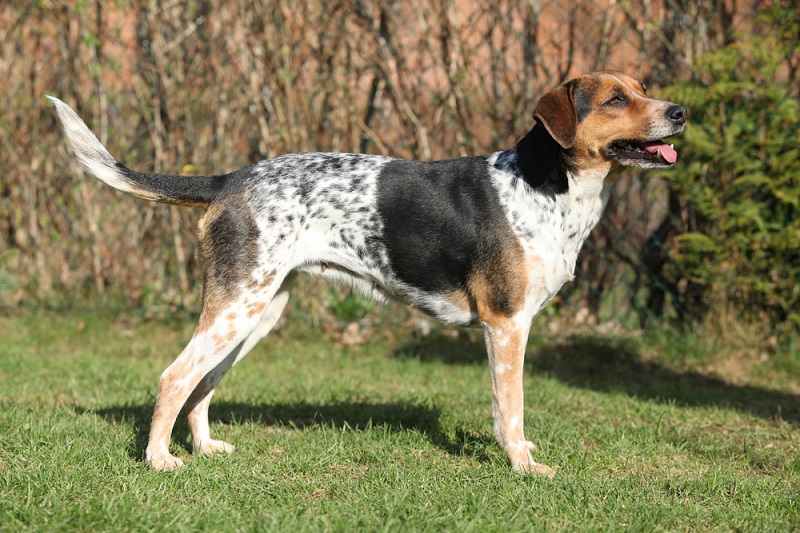
The Bohemian Spotted Dog (Czech: český strakatý pes, originally Horák’s laboratory dog – Horákův laboratorní pes) is a medium-sized dog breed. Originally bred for laboratory purposes by František Horák in Prague in the 1950s, the breed is now primarily a companion dog. This breed is recognized by the Czech Kennel Club but is not FCI recognized.
Czech cynologist František Horák wanted to create an ideal dog for laboratory work. He described the desired characteristics in 1954 – suitable size, smooth coat, high fertility, good nature and low consumption of food. The first litter of pups was given birth in the same year. Even though the breed was bred primarily for experiments, there is minimal evidence of any experiments on Bohemian spotted dogs at the Physiology Institute where the breeding took place. There are some speculations about successful transplantation of kidney and there is a short note of František Horák about it. There is evidence of tissue transplantations and that the dogs were studied for epilepsy. For many years the existence of the breed remained a secret for the public until 1961 when they were presented on a dog show. In 1981 some of the dogs in the institute were given to breeders. That’s when breeders began calling them ‘Bohemian spotted dogs’.
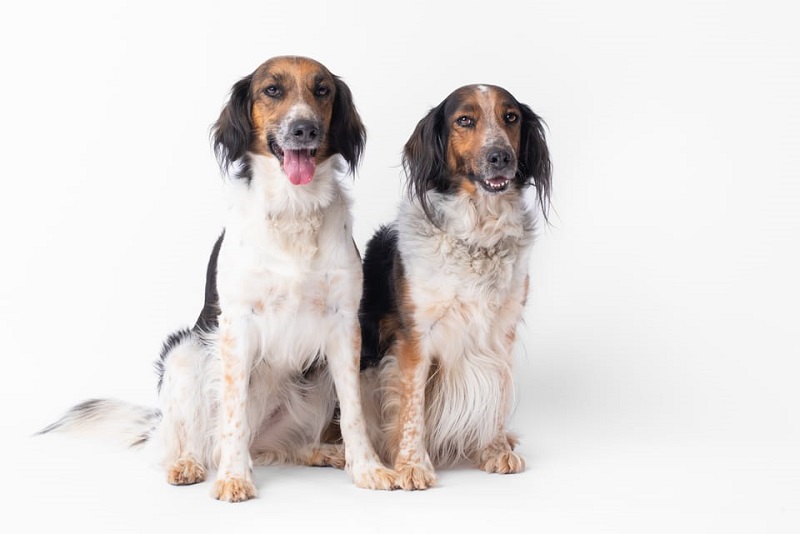
Photo: Pavlína Zábranská
But despite the promising start, the breed wasn’t accepted as well as expected and the dogs were on the edge of extinction. Luckily, few enthusiasts discovered the twisted history of the Bohemian spotted dog and even though there was almost nowhere to start with the rebirth of the breed, they collected 11 dogs all around the Czech Republic. Another litter of pups was born in 1994, which gave the breed new hope.
The breed is an excellent companion for inexperienced owners. They have a kind and outgoing temper. They are not aggressive and they don’t tend to be dominant because of the original purposes they were bred for. Still, they are good guarding dogs because they tend to bark whenever they hear an intruder even though they won’t attack them. They are very friendly towards people and other dogs – they can live in a pack. If trained from a young age they can tolerate other animals, too. They are very active and they are good at sports such as agility and dog dancing. They are known for dog therapy and they are great with little children. They are very playful and have a strong bond with their family. Thanks to their adaptability they are happy to live in an apartment as well.
7) Czech Mountain Dog (Český horský pes)
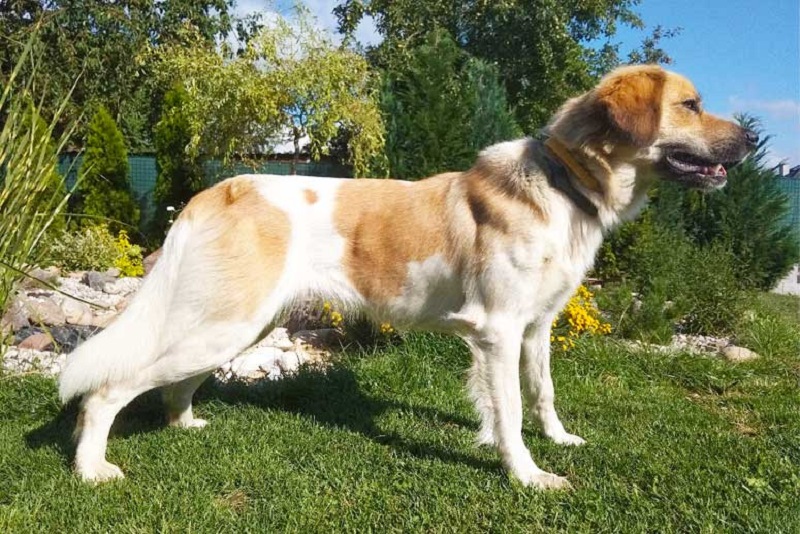
The Czech Mountain Dog originated in the former Czechoslovakia by crossing the Slovak Cuvac and the Canadian Sled Dog. Crossbreeding and breeding began in the 1970s . In 1984 , it was recognized as the Czech national breed. The main intention of the crossing was a dog suitable for local mountain conditions but also a dog suitable for mushing. The first litter of puppies was born on August 12, 1977 in the kennel Třeboň – Kopeček. Seven puppies were born. This breed experienced its biggest “boom” in the 90s of the 20th century , when they were in high demand. Today it is a popular but almost unknown breed even for the Czech public. Today it is used as a pet and an avalanche dog.
They are covered by one breeding club, the Czech Mountain Dog Club . The official abbreviation used is CHP.
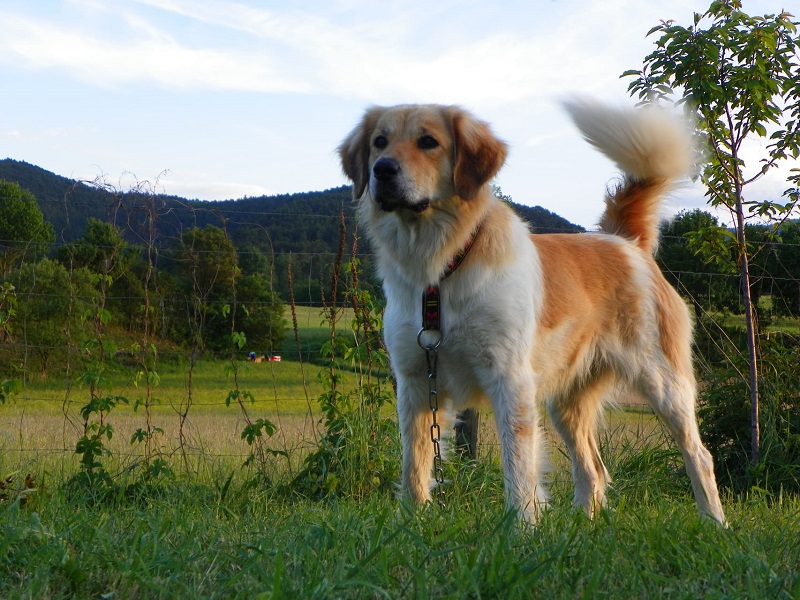
Photo: Anna Rožňová
A versatile sports and working dog, intended for the mountains. He is pleasant, friendly, confident and lively. He is not aggressive. It is relatively easy to train. He likes both children and other animals and dogs. It is suitable for use as a rescuer, shepherd, guard, etc. It is not very dominant. He is playful and active. He behaves aloof towards strangers, but after a while he likes them. It is also a good watchdog and can react aggressively to any unwelcome guest in order to defend the family.
And not really Czech dogs, but those of our Slovak neighbors, include the following:
1) Slovak Cuvac (Slovenský čuvač)
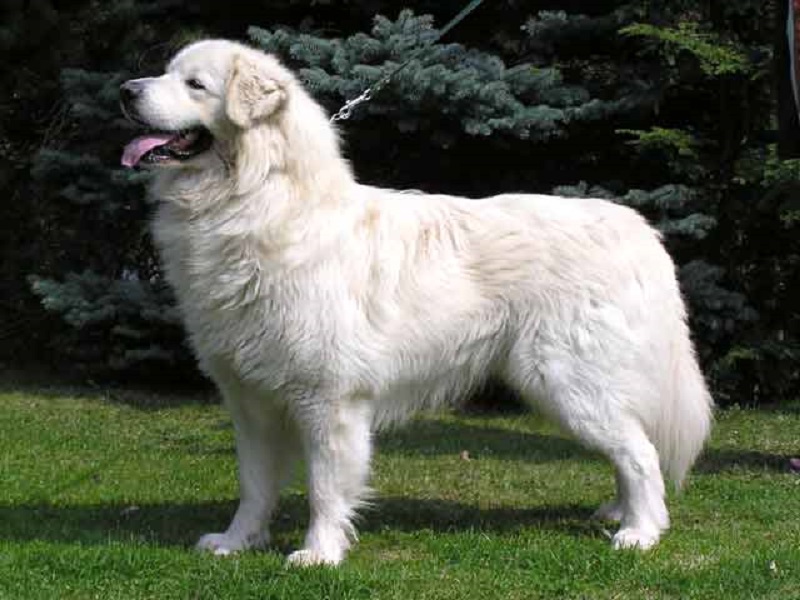
The Slovak Cuvac is a Slovak breed of dog, bred for use as a livestock guard dog. This breed—also known as Slovensky Cuvac, Slovak Chuvach, Tatransky Cuvac and Slovensky Kuvac—is closely related to the Hungarian Kuvasz. The alternate German and English spelling Tchouvatch reflects the pronunciation: chew-votch( čuvati – in serbocroatian language – guarding) . The breed is recognised under sponsorship from Slovakia by the Fédération Cynologique Internationale with the name Slovenský čuvač. Despite the multiple renderings in English, these refer to only one breed. The United Kennel Club in the US uses the English version of the name Slovak Cuvac.
A good watchdog, guard, shepherd and companion, the dog proved itself also in watching cattle, turkeys, and other domestic animals – as well as its master’s household. Holiday makers and visitors to the mountains and spas took to this breed and began to carry it to the lowlands. The Slovensky Cuvac is used on sheep farms and mountain ridges as well as homes and frontiers. He is boundlessly loyal and stout hearted. He resists every enemy – bears and wolves included. According to the time honored shepherd’s tradition, he is always bred in white to be discernible from the beasts of the night.
This breed has been well documented as far back as the 17th century. However, as wolves slowly began to disappear from European mountains and modern herding practices were instituted, the Cuvac was faced with the prospect of being seen as a relic of the past. What few specimens were left in the 1950s were bred carelessly. Credit for reviving the breed and fixing characteristics is due Dr. Antonin Hruza, in cooperation with the veterinary school of Brno.
The registered breeding of the Slovensky Cuvac was established in Czechoslovakia by Professor Antonin Hruza from the Veterinary Faculty in Brno on June 4, 1929. The Club of the Breeders of Slovak Cuvac was established in 1933 and a written standard was established and approved in 1964 Dr. V. Kurz). The basic breeding material came from the vicinity of Liptovska Luzna, Kokava and Vychodna as well as from Rachov in the Carpathians.
The dog is known for its hardy constitution, sturdy frame and shaggy white coat. Its frame is massive, and his temperament is naturally lively, watchful, undaunted and alert. These dogs thrive best in an environment of a large family, children and livestock to care for. Farms and ranches make the best homes. These dogs are natural guard dogs. They are gentle and loyal with their family and possessions.
2) Slovak Rough-haired Pointer (Slovenský hrubosrstý Stavač)
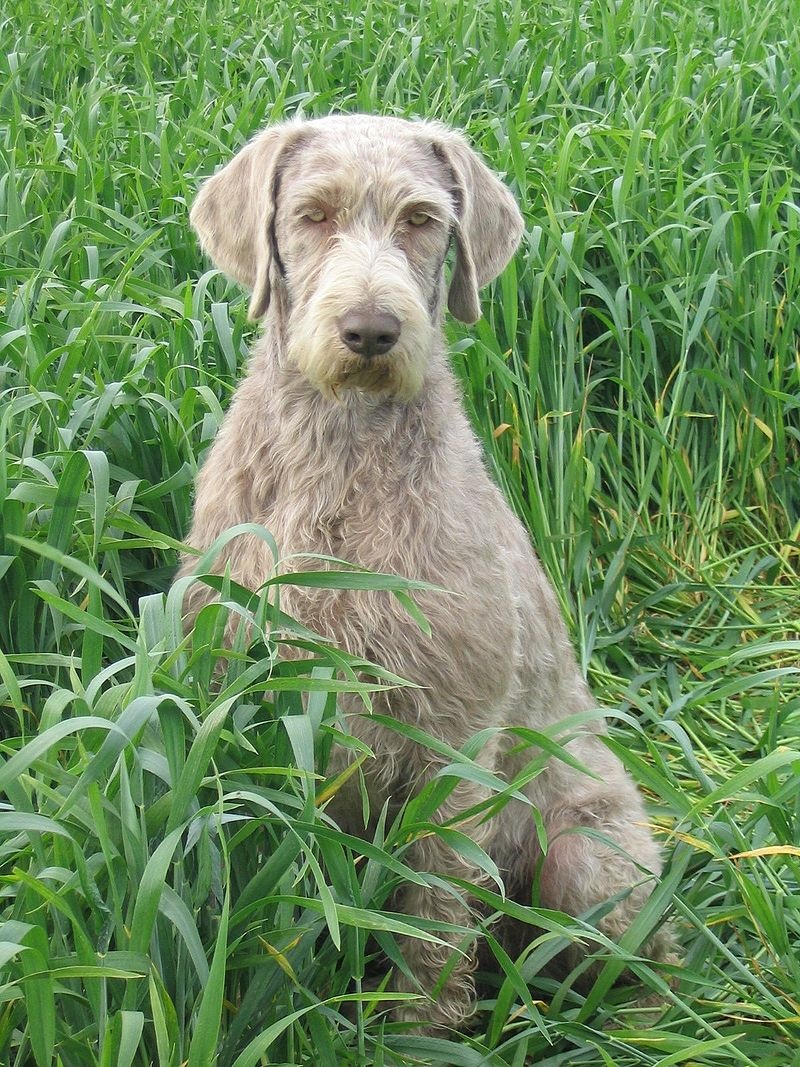
The Slovak Rough-haired Pointer is a gundog breed developed after World War II in Slovakia. It is known by many confusingly similar names in English, including the Slovak Wirehaired Pointer, the Slovak Pointing Griffon, the Slovak Wirehaired Pointing Griffon, and the Slovak Wirehaired Pointing Dog. Its closest relative is the Bulgarian Hound.
Despite the nearly identical names, the SRHP is not the same as the Wirehaired Pointing Griffon, a smaller but similar breed with a slightly longer coat developed for essentially the same purposes by the Dutch and now most common in France.
In the original Slovak, the SRHP breed is known as the Slovensky Hrubosrsty Stavac (Ohar), or the Slovenský Ohař Hrubosrstý In other languages, this breed is referred to as the Griffon d’arret Slovaque a Poil Dur, Slowakischer Rauhbart, and the Grifon de Muestra Eslovaco de Pelo Duro.
At one point, the Slovaks who developed the breed asked the Weimaraner Club of Germany to recognize this dog under the name Rough-haired Weimaraner, but the request was rejected.
The breed was established by crossing German Wirehaired Pointers, Weimaraners, and the Cesky Fousek (also known as the Bohemian Wirehaired Pointing Griffon). The SRHP breed has had slight input from the German Wirehaired Pointer and Pudelpointer as well. The developer, Koloman Slimak, wanted a dog with great stamina which would track, point, retrieve in water or land, and be suitable for a range of prey from birds, hares and other small animals, and large game up to the size of deer.
The breed was accepted by the FCI in 1985 or 1995 and categorized as a Continental Pointing Dog of the braque type. It is not yet recognized by the AKC in the U.S. First introduced into the United Kingdom in 1997, they were featured in a “meet the breed” segment of the 2007 broadcast of the famed Crufts dog show in Britain. The breed is also recognized by the North American Versatile Hunting Dog Association and the Malaysian Kennel Association.
The breed is an excellent worker, and its eagerness to please make it extremely amenable to training. The Slovakian Rough Haired Pointer has a rough coat that does not shed but requires weekly brushing to keep it in good condition. The breed is affectionate and generally good with children, although its size and energetic nature mean it should be supervised around small children. The Slovakian Rough Haired Pointer has high energy levels and needs an active lifestyle, ideally in a rural environment.
3) Slovak Hound (Slovenský kopov)
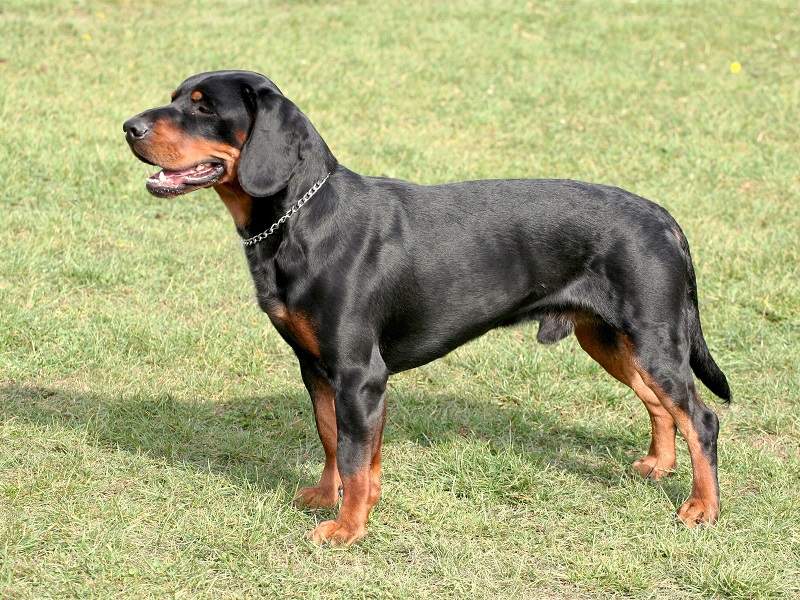
The Slovenský kopov (translated into English as Slovak Hound) is a medium-sized breed of hunting dog of the scent hound type. The breed originated in Slovakia, in Central Europe, and is bred for boar hunting. The name Black Forest Hound seems to have been created in North America for marketing purposes, since the breed has no connection with the Black Forest.
A well-known type of hunting dog since antiquity, today’s breed was first recognized in the 1870s. The breeds of Brandlbracke (Austrian Black and Tan Hound), Chart Polski (Polish Greyhound), and Magyar agár (Hungarian Greyhound) are believed to have been used in the breed’s background. The etymology of the name seems to refer to the dog’s color. The breed club was established in Bratislava in 1988.
The Slovenský kopov was developed and is used as a hunting dog, not a pet or show dog. It is bred for hunting large game, especially wild boar. Although extremely common in its area of origin, it is rarely seen in other countries. The Slovenský kopov is similar to other East European scent hounds in appearance and hunting style.
The breed is recognized in its country of origin with the name Slovenský kopov, and is listed for international dog sports competition with the Fédération Cynologique Internationale under that name as breed number 244, in Group 6, Scent hounds and Related Breeds, Section 1.2 Medium-sized Hounds. Exported to North America, the breed is recognixed under the English translation of its name, the Slovakian Hound, by the United Kennel Club in the United States. The breed also may be registered under a variety of translations of the name, or created English names such as the Black Forest Hound, with minor kennel clubs, hunting clubs, and internet dog registry businesses, and promoted as a rare breed for those seeking an unusual hunting dog or a unique pet.
Though known to be independent, it is intelligent, and is easy to train. Also, it is blessed with a good sense of direction.
4) Slovak Coarse-haired Hound (Slovenský ohař hrubosrstý)
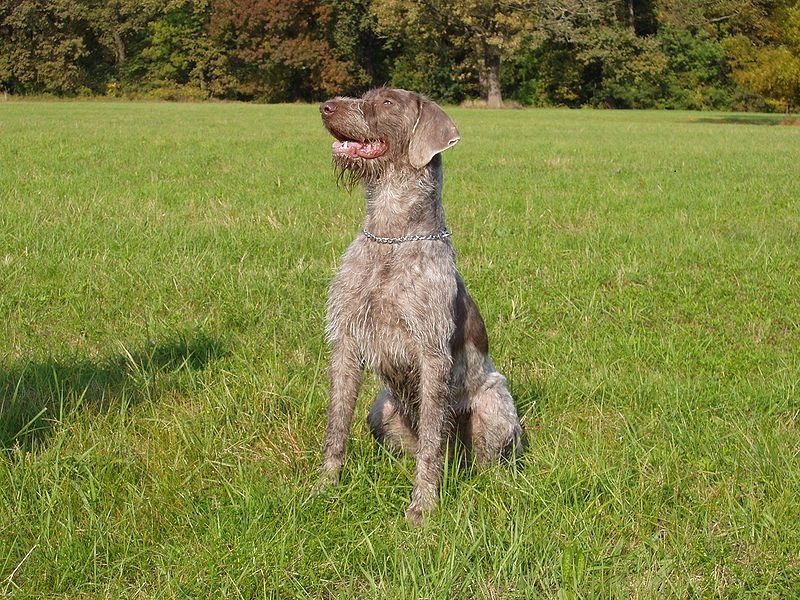
The Slovak Rough-haired Hound is a newer dog breed originating from Slovakia. Weimaraner short-haired hounds , Czech fousek and German wire -haired hounds were used in its breeding. Crossing these dogs was the idea of Slovak cynologist Slimák. It was bred in 1975. In the old literature, it can also be found as the Weimaraner rough-haired hound, but in 1973 it was renamed as we know it today and from that year it was kept as a separate breed. In 1983 the FCI was officially recognized and the first standard was written. In what was then Czechoslovakiait was recognized in 1975. The official abbreviation used in the Czech Republic is SHO. As for the breeding of Slovak rough-haired hounds in the Czech Republic, the breed is only expanding here and is not very well known among the public. It is mainly used by hunters as a hunting dog.
It is an active dog that needs constant exercise. It would suit an active family, but probably best if it can be taken to work with a family member if they have an outside job. It likes to be outside and given the chance to run around and be close to it’s owner. They are good with children and other dogs is socialized early on and are usually accepting of strangers, if they are used to visitors popping in. They have a laid back and affectionate temperament. They are sociable dogs who will do best when fully integrated into the family. Generally happy to meet strangers and should get on fine with other pets – especially if raised with them. These are also very energetic dogs who will be restless and destructive if they don’t get enough daily exercise.
And Now… A Czech Girl and Her Dog
Speaking of dogs, have you met my dog Richard?
I haven’t yet introduced you?
Well then, I suppose now is the best time!
Below is a collage of photographs of the two of us.
He’s my little prince and I absolutely adore him. My daughter Zynnia gave him to me for Christmas this past year. I admit, I didn’t want a dog because I’ve been without one for the last 15 years, but he won me over and I fell in love instantly. As you can see, he is my sidekick, my constant companion, and my very best friend.
Isn’t he just adorable? I post a lot of him (especially videos) on my Instagram account. He brings me many smiles each and every day.
Of course, Richard is not a Czech dog. He’s a Shiba Inu, a Japanese breed.
Shiba Inu is an ancient breed, having been around since 300 B. C. The breed is named after its history as a hunter in the rugged mountains of Japan; “Shiba” means “brushwood” (referring either to the brush in the mountains or to the dog’s reddish color) in Japanese, and “Inu” means “dog.”
A very confident dog, the Shiba Inu temperament is alert, loyal and lively and they tend to form incredibly strong bonds with their owners. However, they can also be quite independent at times, quite territorial, and they possess a strong hunting instinct. Most Shibas cannot be trusted off leash because they are natural hunters and they love the chase. The Shiba Inu has been known to show the fiery side of his personality with other dogs. They are not really fond of other dogs – especially of the same sex.
Perhaps this is because Shiba Inu are a basal breed of dogs that exhibit more wilder traits than more domesticated dogs. (A basal dog breed is more related to wolves than domesticated dog breeds, they have numerous traits passed down from their wolves ancestors.) Because Shiba Inus are a more primitive dog breed, they don’t enjoy excessive handling, especially from strangers. An indelible personality trait of the Shiba Inu is their aloofness. In fact, the aloofness of Shiba Inus is an endearing trait to Shiba Inu owners. Many have described their personality as similar to a cat which is true in many ways. Like cats, Shiba Inus are fastidious, proud, and very independent.
Shibas possess stellar intuition as well. It is said you should always trust your Shiba Inu and be aware of his (or hers) reaction to strangers. In many cases, your Shiba Inu’s judgement of strangers will be better than yours.
The Japanese are proud of this ancient breed because they are good natured, loyal, and charming. Shiba Inus have a total trust and attachment to it’s owner. The bond between a Shiba Inu and it’s owner is a very special partnership that will last for the Shiba’s lifetime. Usually, a Shiba Inu will only take one master in his or her lifetime.
And you can see how NOT-Czech he is in this video, where he’s terrified of and barking at poppyseed koláč!
View this post on Instagram
Confession — he’s learned to like koláče as much as his mama.
Thank you for your support – We appreciate you more than you know!
We know that you could spend hours, days, weeks and months finding some of this information yourselves – but at this website, we curate the best of what we find for you and place it easily and conveniently into one place. Please take a moment today to recognize our efforts and make a donation towards the operational costs of this site – your support keeps the site alive and keeps us searching for the best of our heritage to bring to you.
Remember, we rely solely on your donations to keep the project going.
Thank you in advance!
If you have not already subscribed to get TresBohemes.com delivered to your inbox, please use the form below now so you never miss another post.

